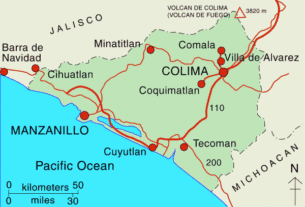Traveling to Mexico is like having a fling, a stunning romance, a love affair so intense that everything becomes a romantic vision. Senses are heightened, feelings revive, and travelers find themselves newly innocent and unfettered by the constraints of their own societies. Depending upon our temperament, we are at once profoundly carried away so that we either live on oxygen alone, or gorge ourselves on each heady experience as if it was one more in an endless line of sensual feasts. Our deepest longings, previously dormant, are given a voice in which to express the stirrings of our hearts, the range of our feelings, the once-still voices of our souls. Magic is rediscovered.
Moving to Mexico, however, is not unlike getting married. Perhaps we’ll marry Mexico for romance, for adventure, or to elevate our spiritual or economic status, but once the honeymoon is over one begins to notice that the language and customs of our beloved are strikingly dissimilar to our own. The informal intimacies of our native interactions clash with the formality of Mexican decorum. Our simplest needs cannot be communicated—not to mention our more complex feelings and ideas. When once all we could see were bougainvillea-covered walls and cobbled streets, we begin to see differing attitudes toward ecology, animals, consumerism, democracy, and staggering differences in technological and informational sophistication. For all the genuine beauty Mexico offers, people who make the commitment to relocate here must consider the differences between the societies of North America and Mexico. The real work of compromise begins, as it does in all marriages, and it must be noted for the record, that divorce is a genuine option.
The nearly six years that I’ve spent in small villages in Mexico has taught me more about our cultural differences than I ever expected, emboldened as I was by my optimistic North American “can do” attitude, fueled by an economic dominance I only vaguely acknowledged, and by overestimating the value of gleaned information from the value of authentic experience. Because my relocation occurred in small villages, I was not pitted socially or economically against those who would have been my Mexican peers. Like many newlyweds, I found myself developing a storehouse of peculiar notions and frustrations “about Mexico” that edged their way into the early days of my wedlock. I needed to Get Used to Things.
Mexico is only just now inching toward the kind of democracy that North Americans know. It continues to be tied to a tradition of military coercion and political and economic feudalism. Widespread fiscal accountability is not yet a reality and payoffs and bribery at every level are common.
Unconsciously, North Americans expect a classless society, mistaking the life of the people in the villages, with their gentle attitudes toward children, commitment to family, and boundless hospitality, to be a microcosm of the country as a whole. It isn’t necessarily so. As class rank rises, so does the ennui of the bored teenager, the jaded socialite, and the trapped executive. Many newcomers, hailing from the great middle class of North America, carry conflicted ideas about domestic help, committing beaucoup de faux pas with the Mexican working classes by making unwanted overtures or conversely by harboring unrealistic expectations. If your housekeeper has never seen a Cuisinart, how can you expect her to clean it, much less operate it?
Because of North America’s geographical isolation, we are not required by necessity, as are other regions of the world, to learn other languages (excepting Canada’s province of Quebec and the U.S.-Mexico border states). Canadians and Americans as a whole are unprepared to deal with the realities of mastering another language. Because of the generosity of Mexicans to tolerate our attempts to speak Spanish, the task is lightened, but preparation in this area is often seriously underevaluated. After all, how can we bond with our lover if we cannot share our innermost thoughts with them in a language we both understand?
In Mexico, especially in the rural areas, animals are often regarded more as tools, than soulful companions to be watched over and cared for like children. The roadside carnage of free-ranging cats, dogs, horses, burros and cows mowed down by cars and trucks can be shocking. The ubiquity of trash, plastic bags, garbage, debris, and refuse of all kinds in Mexico takes North Americans back a generation or two when our own streets and lanes looked more like Tobacco Road than the sterile showplaces that are the norm today. Only after national litter campaigns in the U.S., for example, were younger generations educated about littering, a campaign yet to be initiated in Mexico. Still on the edges of an organic society in which food and the other necessities of life were wrapped or managed in naturally decomposing materials, Mexicans are yet to make the mental leap of the plastic bag and disposable diaper that take a zillion years to decompose. While Mexico still energetically retains its holistic traditions of herbal remedies and homeopathy, it remains naïve about the long-range effects of dangerous chemicals. Gardeners routinely dust with Diazanon and many natural healing clinics overspray pesticides for insect control. Animals are poached, exotic birds are illegally captured, and pollution by industry and automobile waste goes virtually unchecked. Mexico is just now learning the hard lessons of environmental responsibility the developed nations of the world have been forced to embrace.
Other things, especially in the small villages of Mexico need some Getting Used To. Houses are different. Brick, concrete block and rebar rule, building codes are not regulated in most areas, and a kind of technological backwardness is everywhere. Native and time-tested building methods have not lost their value, but for those of us who insist upon the same sophisticated gadgets in our homes here that we had there, must prepare ourselves for difficult learning curves.
Modes of dress are different. Modesty is still observed and European styles are emulated, but not necessarily North American fashions. Our middle class slouchwear, regardless of how much we paid for it, is not de rigeur.
Mexican village society is not a consumer society. Once newly landed newcomers have purchased their fill of the country’s mind-staggering array of superb artesanía, they’ll find that recreational shopping is out. Necessities, especially food, are purchased in the market (if you are wise), accompanied by the subtle social interaction of bargaining. Fierce attitudes about getting the best deal, paranoia about being cheated, and obsessive preoccupation with getting minute amounts of change has created more walls between people than perhaps anything else. This is not to say that there are not those Mexicans and North Americans out there who are not worthy to be, shall we say, “the object of our affections”. A balanced, oftentimes patient and instinctual savvy is what is called for when approaching matters of money.
As if the challenges of our new union with Mexico are not enough, there is the matter of our “inlaws”. That is, our new relationships with other members of the ex-patriate community. The Lake Chapala and Ajijic area is the largest ex-pat community in the world. Coming from diverse cultures of our own, we must juggle their expectations, proprieties, and sometimes ill-conceived advice along with those of our adopted culture.
Finally, Carolyn Myss, co-author of ” The Creation of Health” observes that, “one of the false goals of (North American) life is that we can somehow maneuver our lives in such a way as to avoid difficulties—this is impossible”. There is a significant degree of fatalism in the Mexican psyche that accepts difficulty. This is abundantly reflected in the Day of Dead ceremonies, a unique blend of indigenous Aztec, Mayan, and Christian beliefs in which death is embraced, teased, laughed at, endured and respected. Death and other difficulties, though profoundly experienced, are not denied in Mexico, whereas in North American culture we want guarantees that the unthinkable will not happen. And we’ve got the legal machines to prove it. Things go wrong in Mexico and in some areas recourse is possible, but big-dollar, protracted lawsuits are rare.
Those who enter into their nuptials with Mexico with uninformed childish dreams can expect disappointments and possibly irreparable frustrations and experiences. Those who bring mature, accepting, flexible talents to the task will assimilate well and flourish in their union with this marvelous, exotic land and her people. It is for these thoughtful people that these words are written so that all of us can participate in the emerging country we’ve chosen to love. For all of us, “Que le vaya bien” or “Go Easy” is an apt and true code to adopt.
Teresa’s articles
(Note: For an excellent introduction to the subjects of language and culture read the sections by Gerry Mugford Fowler and Carol Wheeler Esparza in the book, “Lake Chapala and Ajijic: The Insiders Guide to the Northshore for International Travelers” by Teresa A. Kendrick.
Mexico’s Lake Chapala and Ajijic: The Insiders Guide is available from Amazon Books: Paperback


